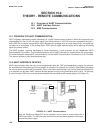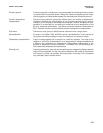
128
TERM DEFINITION
Acid When dissolved in water acids increase the hydrogen ion concentration. Pure
water at 25°C contains 1 x 10
-7
moles per liter of hydrogen ions (H
+
) and an equal
concentration of hydroxide ions (OH
-
). An acid increases the hydrogen ion con-
centration above the value found in pure water and decreases the hydroxide ion
concentration. However, the product of the hydroxide and hydrogen concentra-
tions remains constant.
Activity Physical and chemical measurements made in real solutions are usually different
from the values predicted from the behavior in ideal solutions. Activity is a way of
accounting for the discrepancy. For ions in solution ideal behavior occurs at infi-
nite dilution. Infinite dilution means the solution contains so few ions that they
behave independently of one another. As the concentration of the ions increase,
they start to interact and the properties of the solution begin to deviate from the
ideal. The ratio of the true value to the ideal value at a given concentration is the
activity coefficient. The product of the activity coefficient and the concentration is
the activity. For electrolytes, the activity is always less than the concentration.
Alkalai metal The alkalai metals are lithium, sodium, potassium, and cesium. They form ions
having unit positive charge. Ion exchange reactions involving alkalai metal ions
cause certain types of glass to develop electrical potentials in the presence of
hydrogen ions.
AMS AMS is an acronym for Asset Management Solutions. AMS is software running in
Windows 95 that allows the user, sitting at a computer, to view process measure-
ments, program transmitters, and review maintenance and performance records.
Balco RTD The sensing element in a Balco RTD is an alloy containing 70% nickel and 30%
iron. Balco RTDs are identified by their resistance at 25°C. The resistance
changes about +0.45% per °C.
Base When dissolved in water bases decrease the hydrogen ion concentration. Pure
water at 25°C contains 1 x 10
-7
moles per liter of hydrogen ions (H
+
) and an equal
concentration of hydroxide ions (OH
-
). A base decreases the hydrogen ion con-
centration below the value found in pure water and increases the hydroxide ion
concentration. However, the product of the hydroxide and hydrogen concentra-
tions remains constant. Alkalai is another word for base.
Buffer (calibration) A calibration buffer is a solution having accurately known pH. Calibration buffers
have a nominal pH, which is the pH at 25°C. Changing the temperature changes
the pH value of a buffer. Buffers define the pH scale and are used to calibrate the
response of pH measurement cells.
Buffer The term buffer generally refers to a solution that resists changes in pH upon dilu-
tion or the addition of small amount of a strong acid or base.
Calibration Chemical sensors are transducers. They produce a signal related to concentra-
tion or to a physical property. Calibration is the process of assigning known con-
centrations or known physical values to the sensor signal. Because the relation-
ship between sensor output and physical or chemical property is often linear, only
one or two calibration points are needed.
MODEL 3081 pH/ORP SECTION 16.0
GLOSSARY
SECTION 16.0
GLOSSARY


















